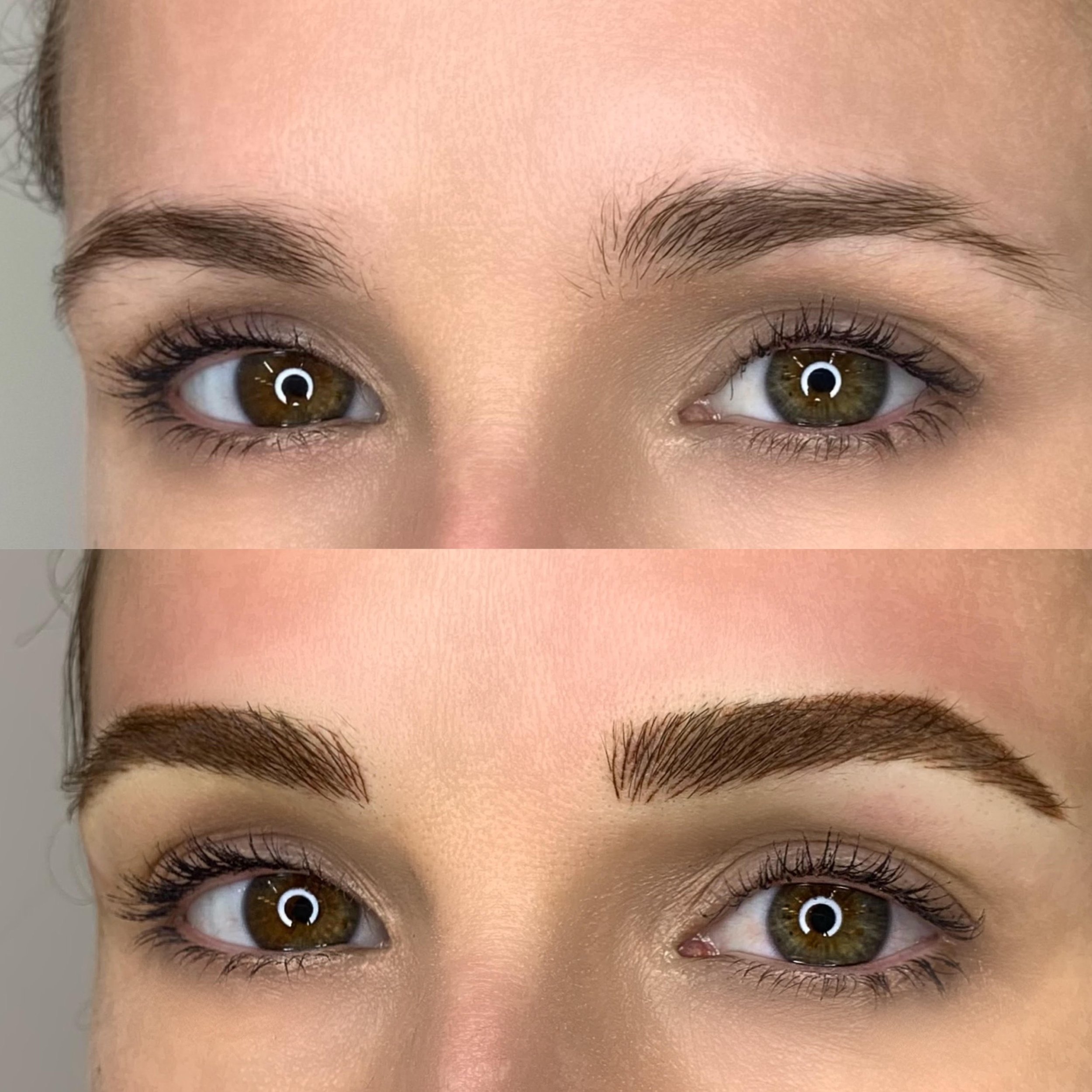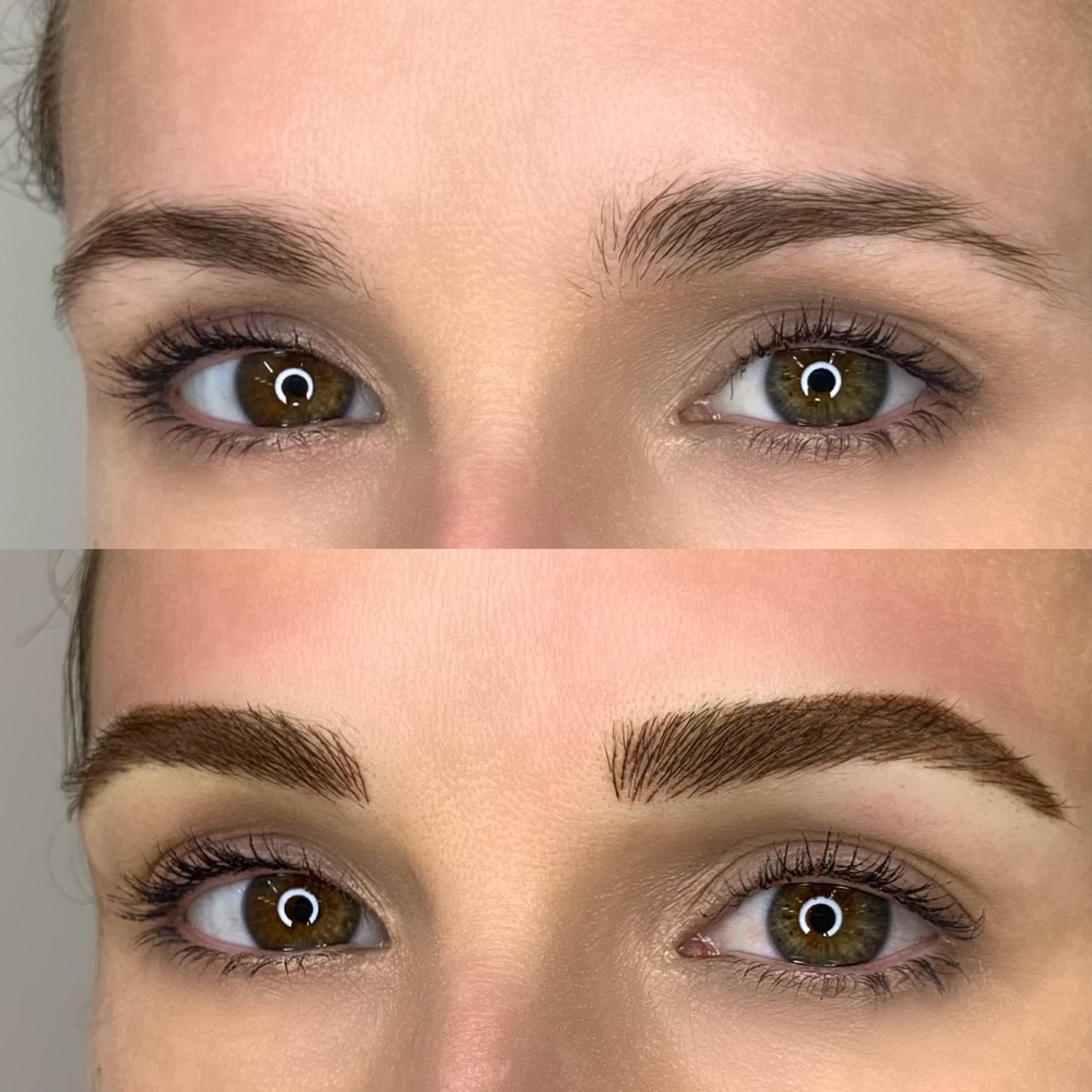
Eyebrow tattooing, often called microblading or semi-permanent makeup, is a cosmetic procedure that involves applying pigment to the skin to enhance or create the appearance of fuller eyebrows. This technique has gained immense popularity recently, particularly among individuals seeking to address sparse or uneven eyebrows due to over-plucking, aging, or medical conditions. Unlike traditional tattooing, which uses a machine to inject ink deep into the skin, eyebrow tattooing typically employs a manual tool with fine blades that deposit pigment into the upper layers of the skin.

This method allows for greater precision and a more natural look, mimicking the appearance of individual hair strokes. The process of eyebrow tattooing can vary in technique and style, with options ranging from soft, powdery finishes to more defined, hair-like strokes. The choice of technique often depends on the desired outcome and the natural characteristics of the client’s eyebrows.
Microblading, for instance, is favored for its ability to create realistic-looking brows that blend seamlessly with existing hair. The results can last anywhere from one to three years, depending on skin type, lifestyle, and aftercare practices. As a result, eyebrow tattooing has become a go-to solution for those looking to save time on their daily beauty routines while achieving a polished and well-groomed appearance.
Key Takeaways
- Eyebrow tattooing is a semi-permanent cosmetic procedure in which pigment is applied to the skin to create the appearance of fuller, more defined eyebrows.
- The benefits of eyebrow tattooing include saving time on daily makeup application, achieving a natural-looking result, and boosting confidence.
- When choosing the right eyebrow tattoo artist, it is important to research their qualifications, experience, and portfolio of previous work to ensure a safe and satisfactory outcome.
- Before undergoing eyebrow tattooing, it is important to prepare by avoiding certain medications, alcohol, and caffeine and discussing any medical conditions with the tattoo artist.
- The eyebrow tattooing process involves a consultation, customizing the shape and color of the eyebrows, numbing the area, and then applying the pigment using a specialized tattooing technique.
Benefits of Eyebrow Tattooing
One of the primary benefits of eyebrow tattooing is the significant reduction in daily grooming time. For individuals who spend considerable time each morning filling in their brows with pencils or powders, the convenience of having well-defined eyebrows can be life-changing. Once the procedure is completed, clients can enjoy the freedom of waking up with perfectly shaped brows without the need for extensive makeup application.
This time-saving aspect is particularly appealing for busy professionals, parents, or anyone with a fast-paced lifestyle. In addition to convenience, eyebrow tattooing offers a solution for those struggling with eyebrow hair growth for various reasons. Conditions such as alopecia or hormonal imbalances can lead to thinning brows, making it challenging for individuals to achieve their desired look.
Eyebrow tattooing restores confidence by creating the illusion of fuller brows. Furthermore, the procedure can be customized to suit individual preferences regarding shape, color, and density, allowing clients to achieve a look that complements their facial features and personal style. This level of personalization enhances overall satisfaction with the results.
Choosing the Right Eyebrow Tattoo Artist
Selecting the right eyebrow tattoo artist is crucial for achieving optimal results and ensuring a safe experience. Prospective clients should conduct thorough research before making a decision. One effective approach is to seek recommendations from friends or family members who have undergone similar procedures.
Additionally, online reviews and social media platforms can provide valuable insights into an artist’s skills and reputation. It is essential to look for artists specializing in eyebrow tattooing and have a portfolio showcasing their previous work. When evaluating potential artists, it is important to consider their qualifications and certifications.
Many regions require specific training and licensing for cosmetic tattooing practitioners. A reputable artist should be able to provide proof of their training and demonstrate adherence to health and safety regulations. During initial consultations, clients should feel comfortable asking questions about the artist’s techniques, tools, and aftercare recommendations.
A skilled artist will take the time to understand the client’s preferences and offer professional advice on achieving the best results based on individual facial features.
Preparing for Eyebrow Tattooing
| Aspect | Details |
|---|---|
| Consultation | Discuss the desired shape and color with the technician |
| Preparation | Avoid alcohol and blood-thinning medications before the procedure |
| Aftercare | Avoid getting the area wet and apply healing ointment as directed |
| Healing Time | Expect 7-14 days for the eyebrows to heal fully |
Preparation is key to ensuring a successful eyebrow tattooing experience. Before scheduling an appointment, clients should take some time to consider their desired brow shape and color. Browsing through inspirational photos can help clarify preferences and provide a reference point for discussions with the artist.
It is also advisable to avoid any blood-thinning medications or supplements in the days leading up to the procedure, as these can increase the risk of excessive bleeding during the tattooing process. On the appointment day, clients should arrive with clean skin and minimal makeup around the brow area. Many artists will perform a patch test to check for any allergic reactions to the pigments used in the procedure.
This step is particularly important for individuals with sensitive skin or allergies. Additionally, clients should communicate openly with their artists about any concerns or questions regarding the procedure. A thorough consultation will help establish trust and ensure that both parties are aligned on expectations.
The Eyebrow Tattooing Process
The eyebrow tattooing process typically begins with a consultation, during which the artist assesses the client’s natural brow shape and discusses their desired outcome. This initial step is crucial for determining the best approach to achieving a harmonious look that complements the client’s facial features. Once a plan is established, the artist will outline the desired shape using a pencil or marker, allowing the client to visualize the final result before applying any pigment.
After finalizing the shape, the artist will prepare for the tattooing process by sterilizing their tools and ensuring a clean working environment. A topical anesthetic is usually applied to minimize discomfort during the procedure. The tattooing involves using a handheld microblading tool or machine to deposit pigment into the skin in fine strokes that mimic natural hair growth.
The duration of this process can vary depending on individual preferences and complexity, but it generally takes one to two hours. Throughout this time, communication between the client and artist is essential to ensure satisfaction with each step.
Aftercare for Eyebrow Tattoos
Proper aftercare is vital for ensuring optimal healing and longevity of eyebrow tattoos. Immediately following the procedure, clients may experience some redness or swelling around the brow area; this is normal and typically subsides within a few hours. Artists usually provide specific aftercare instructions, including avoiding water exposure on the brows for several days, refraining from applying makeup directly on the area, and steering clear of sun exposure or tanning beds during the healing process.
In addition to these guidelines, clients should avoid picking at scabs or peeling skin as their brows heal. This can lead to uneven fading or loss of pigment in certain areas. Instead, clients should gently cleanse their brows with mild soap and water as directed by their artist and apply any recommended healing ointments sparingly.
Following these aftercare instructions diligently will help ensure that the final results are as beautiful and long-lasting as possible.
Potential Risks and Side Effects
While eyebrow tattooing is generally considered safe when performed by a qualified professional, there are potential risks and side effects that clients should be aware of before undergoing the procedure. One common concern is allergic reactions to pigments used during tattooing. Although rare, some individuals may experience itching, redness, or swelling in response to certain ingredients in the ink.
Conducting a patch test before treatment can help mitigate this risk. Infection is another potential complication of eyebrow tattooing if proper hygiene practices are not followed during and after the procedure. Clients should ensure that their chosen artist adheres strictly to sanitation protocols, including using sterile tools and maintaining a clean workspace.
Additionally, individuals with certain medical conditions or skin sensitivities may be at higher risk for complications; therefore, clients must disclose their medical history during consultations.
Maintaining Your Eyebrow Tattoo
Maintaining eyebrow tattoos involves regular care and attention to remain vibrant and well-defined. While semi-permanent tattoos can last from one to three years, depending on factors such as skin type and lifestyle habits, periodic touch-ups may be necessary to refresh color and shape as fading occurs naturally over time. Many artists recommend scheduling touch-up appointments every 12-18 months to maintain optimal results.
To prolong the life of an eyebrow tattoo, clients should adopt certain practices in their daily routines. This includes using gentle skincare products around the brow area and avoiding harsh exfoliants that could accelerate fading. Additionally, sun protection is crucial; applying sunscreen on exposed areas can help prevent UV damage that may lead to premature fading of pigments.
By following these maintenance tips and staying in touch with their artist for follow-up care, clients can enjoy beautifully defined eyebrows for years to come.
FAQs
What is an eyebrow tattoo?
An eyebrow tattoo, or microblading or permanent makeup, is a cosmetic procedure in which pigment is implanted into the skin to create the appearance of fuller, more defined eyebrows.
How is an eyebrow tattoo done?
During an eyebrow tattoo procedure, a technician uses a small handheld tool with tiny needles to create small, hair-like strokes in the skin, depositing pigment to mimic the look of natural eyebrow hairs.
How long does an eyebrow tattoo last?
The longevity of an eyebrow tattoo can vary depending on factors such as skin type, lifestyle, and aftercare. Generally, it can last anywhere from 1 to 3 years before needing a touch-up.
Is an eyebrow tattoo painful?
The level of discomfort experienced during an eyebrow tattoo procedure can vary from person to person. Some individuals may feel mild pain or a scratching sensation, while others may find it more painful. Topical anesthetics are often used to minimize any discomfort.
What are the potential risks of getting an eyebrow tattoo?
Potential risks of getting an eyebrow tattoo include infection, allergic reactions to the pigment, and dissatisfaction with the results. To minimize these risks, it’s important to choose a reputable and experienced technician.
How should I prepare for an eyebrow tattoo procedure?
Before getting an eyebrow tattoo, it’s important to avoid alcohol, aspirin, and blood-thinning medications for a few days before the procedure. It’s also recommended to avoid waxing or plucking the eyebrows in the weeks leading up to the appointment.
How should I care for my eyebrows after getting a tattoo?
After getting an eyebrow tattoo, it’s important to follow the aftercare instructions provided by the technician. This may include avoiding water, sweat, and makeup on the eyebrows for a certain period of time and applying a healing ointment as directed.
